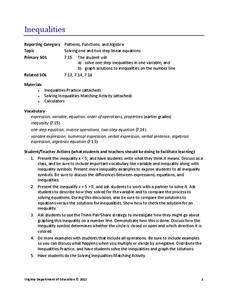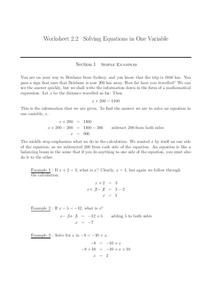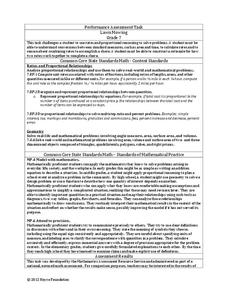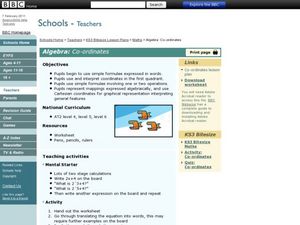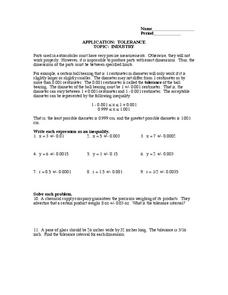Curated OER
Taylor's Theorem
In this Taylor's Theorem learning exercise, students use the microscope approximation to determine the approximate value of a function. They rewrite expressions for the relative error, and observe changes in the relative error. They...
Curated OER
Probability
Students solve probability problems. In this fraction and probability lesson, students review how to simplify fractions and learn how to express probability as a fraction.
Curated OER
Worksheet 11
In this math instructional activity, students define a function f(x) by the following rule: for any x ∈ R,set. They also define the domain and range for the functions.
Curated OER
Scientific Notation
In this scientific notation learning exercise, 9th graders solve and complete 13 different problems that include writing the scientific notation. First, they express each number in scientific notation. Then, students evaluate and express...
Curated OER
Translating Algebraic Phrases
In this algebraic phrases worksheet, students write an algebraic expression for a set of 15 phrases. A website reference for additional resources and an answer key are provided.
Curated OER
Divide Whole Numbers with Decimal Quotients
For this division of whole numbers worksheet, students write division expressions as fractions, write fractions as division expressions and solve 4 word problems.
Curated OER
Worksheet 18 Fall 1995
For each of the equations they find the values of the rational expressions. Then they differentiate each expression in relation to the value of t.
Curated OER
Algebra 1 Properties
In this Algebra 1 properties worksheet, students match the name of the property with the expression for 14 properties used to evaluate and simplify algebraic expression.
EngageNY
Scientific Notation
Young mathematicians learn how scientific notation is meant to save time. Part 10, out of a series of 15, asks scholars to recognize the correct use of scientific notation and finish by adding and subtracting numbers using...
EngageNY
Estimating Quantities
Apply the concept of magnitude to estimate values and compare numbers. The ninth lesson of the 15-part series asks learners to write numbers to their next greatest power of 10 and then make comparisons. Scholars begin to understand the...
EngageNY
Cones and Spheres
Explore methods for finding the volume of different three-dimensional figures. The 20th lesson plan in the 25-part series asks learners to interpret diagrams of 3-D figures and use formulas to determine volume. Scholars must use the...
Virginia Department of Education
Inequalities
Not all resources are created equal — and your class benefits! Scholars learn how to solve one-step inequalities using inverse operations. They complete an activity matching inequalities to their solutions.
Curated OER
Solving Equations in One Variable
In this solving equations in one variable worksheet, students solve 38 simple and complex equations. Students then write and solve equations for 6 word problems.
Curated OER
Related Rates Problems: An Application of Implicit Differentiation and the Chain Rule
In this related rates problem activity, students use the chain rule and implicit differentiation to solve related rate problems, such an writing an expression relating to the ripple of a circle. This three-page activity contains eleven...
Curated OER
Rational Functions
In this college level Pre-Calculus worksheet students evaluate rational functions, identify the domain, vertical asymptotes, and x- and y-intercepts. The three page worksheet contains forty problems. Answers are provided.
Noyce Foundation
Lawn Mowing
This is how long we mow the lawn together. The assessment requires the class to work with combining ratios and proportional reasoning. Pupils determine the unit rate of mowers and calculate the time required to mow a lawn if they work...
Inside Mathematics
Quadratic (2009)
Functions require an input in order to get an output, which explains why the answer always has at least two parts. After only three multi-part questions, the teacher can analyze pupils' strengths and weaknesses when it comes to...
Virginia Department of Education
Greetings
Welcome learners to the world of algebra. Use a activity that poses a situation involving the profit from creating greeting cards to teach about algebra. It requires scholars to use linear functions and inequalities to solve problems.
Curated OER
Algebra: Co-ordinates
Students use Cartesian coordinates. In this graphing lesson students use simple formulae, interpret coordinates, and create graphical representations. They express their work algebraically.
Curated OER
Review of Limits
In this limit worksheet, students review limits stated as an expression, analyze Euler's method applied to a rate equation, compute the terms of a given sequence, and identify a sequence as a convergence or divergence. this four-page...
Curated OER
Seesaw Balances
Students determine how the weights of 7 objects on a seesaw can vary and still be in balance. They also write equations in algebraic terms, how to change 3 variables in an equation expressed in algebraic terms to obtain the correct...
Curated OER
Logarithms
In this pre-calculus worksheet, students write equations in exponential form and logarithmic form. Students solve and graph logarithmic equations. The two page worksheet contains eighty-six problems. Answers are...
Curated OER
Tolerance
In this tolerance worksheet, 9th graders solve and complete 11 different problems that include determining exact measurements. First, they write each expression as an inequality. Then, students determine the tolerance interval of a...
Curated OER
Scientific Notation
In this scientific notation learning exercise, 9th graders solve and complete 29 different problems that include writing scientific notation in each. First, they express each number shown in scientific notation. Then, students evaluate...











